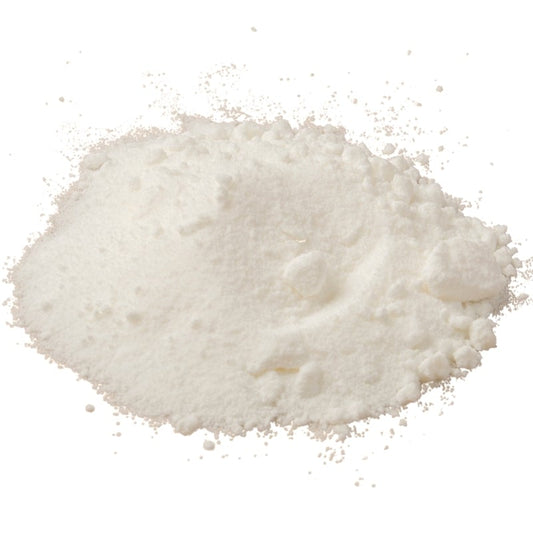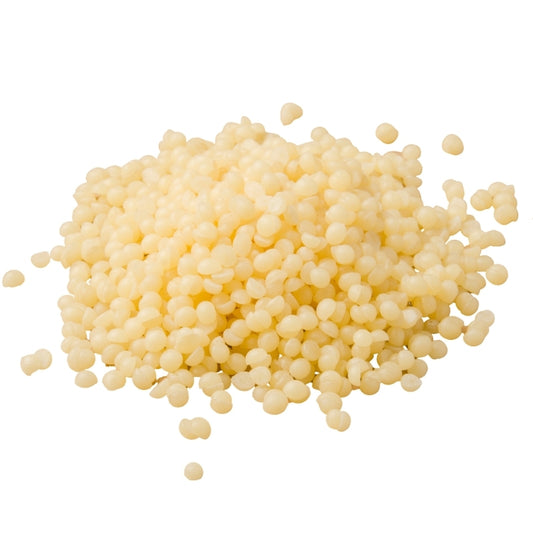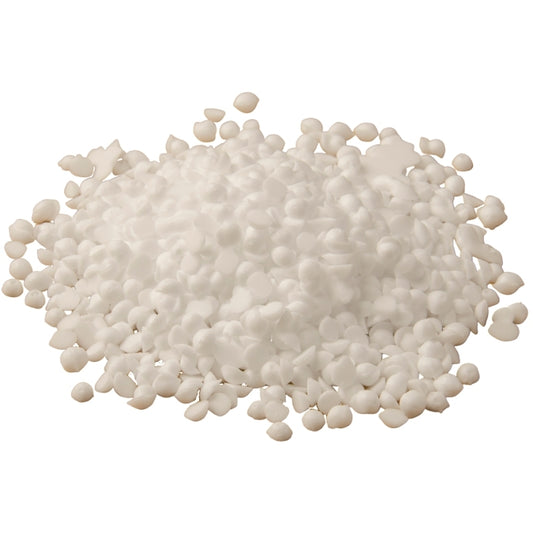
Quick Guide To Emulsifiers
Juliette van der MeerEmulsifiers are the unsung heroes of product formulation, acting as mediators between oil and water. They enable the creation of stable, homogeneous mixtures in everything from cosmetics to food. In this guide, we'll explore your most common questions about emulsifiers, with the specific angle of cosmetics.
What Is An Emulsifier?
Emulsifiers help mix ingredients that don't usually blend, like oil and water. They keep these ingredients from separating. In baking, eggs act this way, and in cosmetics, you get emulsifying waxes and other types of emulsifiers that will blend oils and aqueous ingredients into creams, lotions and other wonderful products.
There are two main types of emulsifiers:
- Oil-in-water (O/W) emulsifiers:
- Used when there's more water than oil
- Result in lighter-feeling products
2. Water-in-oil (W/O) emulsifiers:
- Used when there's more oil than water
- Result in heavier-feeling products
Choose your emulsifier based on whether you want a lighter (O/W) or heavier (W/O) product.
Is Beeswax An Emulsifier?
No! Please don't use beeswax or a vegan plant wax in place of an emulsifying wax, it will not work in the same way. Not every ingredient with the word wax in it will be an emulsifying wax.
Do Emulsifiers Expire?
Most emulsifiers can easily last 2-5 years when stored correctly.
If I Use An Emulsifier Will I Still Need A Preservative?
Yes, because an emulsifier does not have any preservative properties. Anytime you include water/aqueous ingredients in your formulas, you will require a preservative. For further reading on the topic of preservatives check out our Quick Guide To Preservatives.
What Is The Difference Between An Emulsifier And A Solubiliser?
Emulsifiers and solubilizers both help mix oil and water, but they're used in different situations:
- Emulsifiers:
- Used in thicker products like creams and lotions
- Work for both oil-in-water (O/W) and water-in-oil (W/O) mixtures
2. Solubilizers:
- Used in very liquid products like sprays and mists
- Help dissolve small amounts of oil in water
- Only work for oil-in-water (O/W) mixtures
To choose between them:
- For thick products or water-in-oil mixtures, use an emulsifier
- For very liquid products with a small amount of oil in water, use a solubilizer
Why Do I Need An Emulsifier?
Have you ever tried to mix oil and water? They don't play nicely and will always try to separate from each other. When you are formulating you will need an emulsifier whenever you are trying to make products which contain both water/aqueous ingredients and oils in order to blend the two together into an emulsion. If you don't use an emulsifier, you will be left with a sloppy mixture that separates and you won't be able to create lovely creams and lotions.
How To Use An Emulsifier
As a general rule of thumb, emulsifiers are used at 20% of the oil phase. Therefore, the more oil included in your formulation, the more emulsifier you will need to use. The rule of thumb may vary depending on the emulsifier, the type of product you are making and the properties you want the product to have, however.
For example, a typical lotion may use 5-10% emulsifying wax, 10-20% oils and around 75% water. But you can use less or more emulsifier, oils and water to achieve lotions and creams with different feels and textures.
Emulsifiers will most frequently need to be melted and they are usually incorporated into the oil phase of your formula. Bear in mind that some may be liquid and therefore will not require melting, and some may be miscible in your water phase; just check which emulsifier you are using.
What Different Emulsifiers Are Available To Me?
For O/W Emulsions
Eco E wax: an ECOCERT-approved vegetable-derived emulsifying wax for oil-in-water emulsions. It is soluble in oils and will need to be melted to work with.
Eco E wax may be made from various ingredients but it is made from glyceryl stearate.
Usage: generally 4-10% of the formulation, up to 20% of the oils amount, added to the heated oil phase.
Tips: Eco E wax and Polawax can usually be substituted for one another.
Polawax: a vegetable-derived emulsifying wax for oil-in-water emulsions. It is soluble in oils and will need to be melted to work with.
Polawax may be made from various ingredients but our is made from cetearyl alcohol and PEG-20 stearate.
Usage: 20% of your oils amount, added to the heated oil phase.
Tips: Eco E wax and Polawax can usually be substituted for one another.
Olive M 300: a liquid emulsifier that is soluble in both oil and water, it softens the skin too. Great in aqueous based formulas to add a little oil in order to make them more moisturising. It can also help solubilise essential oils. In oil based formulas, it boosts rinse-off: eg. in a bath/shower oil or a product that you would like to self-emulsify with water.
Made up of olive oil PEG-7 esters.
Usage: 1-84%
Weakness: you cannot substitute Olive M 300 with anything else.
Olive M 1000: is a PEG-free, ECOCERT and COSMOS-certified emulsifying wax for oil-in-water emulsions. It comes in large, flat white flakes, and is made from cetearyl olivate and sorbitan olivate, both derived from olives. It makes a really luscious, thick emulsion.
Usage: 2-8%, added to the oil phase. 5% for a serum; 6% for a light cream or lotion; 8% for a cream.
Weakness: it can 'soap': turn white on application when rubbed in.
Tips: you cannot use other Olive M's in place of Olive M 1000, although you can use other emulsifying waxes such as Polawax or Eco E wax as a substitute for Olive M 1000.
Lanolin flakes: an oil-in-water emulsifier and stabiliser. It will help dissolve essential oils and small amounts of carrier in aqueous environments. It is miscible in water.
Usage: 0.5-5% in the heated phased.
Hydrogenated castor oil: an oil-in-water emulsifier and is miscible in both oils and water.
Usage: 1-10%, best used in the heated phase.
For W/O Emulsions
Soy lecithin: water-in-oil emulsifier that is miscible in oils. Lecithin is most commonly used as a co-emulsifier alongside other more powerful emulsifiers
Usage: 0.5-5% added to the oil phase.
Olive M 300: a liquid emulsifier that is soluble in both oil and water, it softens the skin too. Great in aqueous based formulas to add a little oil in order to make them more moisturising. It can also help solubilise essential oils. In oil-based formulas, it boosts rinse-off: eg. in a bath/shower oil or a product that you would like to self-emulsify with water.
Made up of olive oil PEG-7 esters.
Usage: 1-84%
Weakness: you cannot substitute Olive M 300 with anything else.
Olive M 900: is a PEG-free, ECOCERT and COSMOS-certified emulsifying wax composed of sorbitan olivate, a derivative of olive oil.
For water-in-oil emulsions.
Usage:
- 5 - 7.5% in W/O emulsions and foundations as the sole emulsifier
- 1 - 10% as a powder dispersant or lipogel agent
- 1 - 3% as a functional lipid
- 1 - 2% as an O/W co-emulsifier
- 2 - 3% as a W/O co-emulsifier
Ingredients like surfactants, vegetable cetyl alcohol, cetostearyl alcohol and stearic acid also have emulsifying properties but are not emulsifiers on their own.














13 comments
Please advise do you need an emulsifier to blend Shea butter with carrier oil and essential oil?
Hi Mo, unfortunately water and oils won’t mix together without the aid of an emulsifier. Have you tried an emulsifier? This will turn your product milky/creamy however, so if you want to keep the clear oils look I would suggest only adding in oil based additives and not water based.
Helo
Please help. l want to make a face and body oil. I want to add a small percentage of water extract inthe formulation. What can l use to blend the 2 have tried but Im not winning
Hi Gizelle, without knowing your full formula and method it is difficult to advise exactly what went wrong sorry. Perhaps let us know so we can better assist?
Hi. I tried a recipe tonight with oil into water. 30ml of oil into 120ml of water solution including soap and witch hazel. I added 20% polawax to the oil solution as per your guidance. Heated it, mixed it. Cooled it down and added my preservative and essential oil. After 5min my water split again from the oil, what did I do wrong? Trying to make a makeup remover solution!